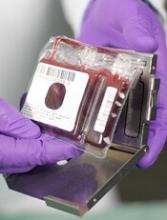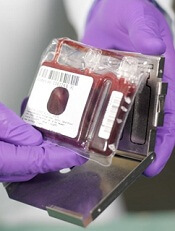User login
Researchers say they have discovered a new approach to expand hematopoietic stem cells (HSCs) from umbilical cord blood (UCB).
The team identified a protein, YTHDF2, that affects multiple targets and pathways involved in HSC self-renewal.
Experiments showed that reducing the function of YTHDF2 allowed UCB HSCs to expand.
The researchers therefore believe this approach could be used to improve UCB transplants.
“If we can expand cord adult stem cells, that could potentially decrease the number of cords needed per treatment,” said Linheng Li, PhD, of Stowers Institute for Medical Research in Kansas City, Missouri. “That’s a huge advantage.”
Dr Li and his colleagues conducted this research and described the work in Cell Research.
Past studies suggested that N6-methyladenosine (m6A) modulates the expression of a group of mRNAs that are critical for stem cell fate determination.
As the m6A reader YTHDF2 promotes targeted mRNA decay, Dr Li and his colleagues decided to target YTHDF2.
The researchers knocked out YTHDF2 function in a mouse model and observed an increase in functional HSCs. However, impairing YTHDF2 function did not alter lineage differentiation or lead to an increase in hematologic malignancies.
The researchers also knocked down YTHDF2 function in human UCB hematopoietic stem and progenitor cells. After 7 days of ex vivo culture, there was a roughly 14-fold increase in both the frequency and absolute number of HSCs with YTHDF2 knockdown (KD) cells compared to control cells.
When human UCB cells were transplanted into mice, there was a 9-fold increase in hematopoietic cell engraftment with YTHDF2 KD cells compared to control cells. In addition, the HSC frequency was about 4-fold higher in YTHDF2 KD cells.
The researchers transplanted bone marrow from primary recipient mice into sublethally irradiated secondary mice and found that, 12 weeks after transplant, human hematopoietic cell chimerism in the bone marrow was higher in YTHDF2 KD mice than in controls.
There was an 8-fold increase in competitive repopulating units from YTHDF2 KD cells compared to control cells.
As for why targeting YTHDF2 results in HSC expansion, the researchers found that YTHDF2 regulates HSC self-renewal gene expression by m6A-mediated mRNA decay.
The team discovered that m6A was enriched in mRNAs encoding transcription factors that are critical for stem cell self-renewal (such as GATA2, ETV6, STAT5, and TAL1). YTHDF2 recognizes these mRNAs and promotes their degradation.
“This work represents a path forward by demonstrating the ability to reliably expand adult stem cells from umbilical cord blood in the laboratory without terminally differentiating the cells into more mature and relatively short-lived blood cells,” said Joseph McGuirk, MD, a professor at the University of Kansas Health System who was not directly involved with this study.
“These findings represent a major advance in the field and have significant potential to improve the outcomes of thousands of children and adults who undergo umbilical cord blood transplantation every year.”
Researchers say they have discovered a new approach to expand hematopoietic stem cells (HSCs) from umbilical cord blood (UCB).
The team identified a protein, YTHDF2, that affects multiple targets and pathways involved in HSC self-renewal.
Experiments showed that reducing the function of YTHDF2 allowed UCB HSCs to expand.
The researchers therefore believe this approach could be used to improve UCB transplants.
“If we can expand cord adult stem cells, that could potentially decrease the number of cords needed per treatment,” said Linheng Li, PhD, of Stowers Institute for Medical Research in Kansas City, Missouri. “That’s a huge advantage.”
Dr Li and his colleagues conducted this research and described the work in Cell Research.
Past studies suggested that N6-methyladenosine (m6A) modulates the expression of a group of mRNAs that are critical for stem cell fate determination.
As the m6A reader YTHDF2 promotes targeted mRNA decay, Dr Li and his colleagues decided to target YTHDF2.
The researchers knocked out YTHDF2 function in a mouse model and observed an increase in functional HSCs. However, impairing YTHDF2 function did not alter lineage differentiation or lead to an increase in hematologic malignancies.
The researchers also knocked down YTHDF2 function in human UCB hematopoietic stem and progenitor cells. After 7 days of ex vivo culture, there was a roughly 14-fold increase in both the frequency and absolute number of HSCs with YTHDF2 knockdown (KD) cells compared to control cells.
When human UCB cells were transplanted into mice, there was a 9-fold increase in hematopoietic cell engraftment with YTHDF2 KD cells compared to control cells. In addition, the HSC frequency was about 4-fold higher in YTHDF2 KD cells.
The researchers transplanted bone marrow from primary recipient mice into sublethally irradiated secondary mice and found that, 12 weeks after transplant, human hematopoietic cell chimerism in the bone marrow was higher in YTHDF2 KD mice than in controls.
There was an 8-fold increase in competitive repopulating units from YTHDF2 KD cells compared to control cells.
As for why targeting YTHDF2 results in HSC expansion, the researchers found that YTHDF2 regulates HSC self-renewal gene expression by m6A-mediated mRNA decay.
The team discovered that m6A was enriched in mRNAs encoding transcription factors that are critical for stem cell self-renewal (such as GATA2, ETV6, STAT5, and TAL1). YTHDF2 recognizes these mRNAs and promotes their degradation.
“This work represents a path forward by demonstrating the ability to reliably expand adult stem cells from umbilical cord blood in the laboratory without terminally differentiating the cells into more mature and relatively short-lived blood cells,” said Joseph McGuirk, MD, a professor at the University of Kansas Health System who was not directly involved with this study.
“These findings represent a major advance in the field and have significant potential to improve the outcomes of thousands of children and adults who undergo umbilical cord blood transplantation every year.”
Researchers say they have discovered a new approach to expand hematopoietic stem cells (HSCs) from umbilical cord blood (UCB).
The team identified a protein, YTHDF2, that affects multiple targets and pathways involved in HSC self-renewal.
Experiments showed that reducing the function of YTHDF2 allowed UCB HSCs to expand.
The researchers therefore believe this approach could be used to improve UCB transplants.
“If we can expand cord adult stem cells, that could potentially decrease the number of cords needed per treatment,” said Linheng Li, PhD, of Stowers Institute for Medical Research in Kansas City, Missouri. “That’s a huge advantage.”
Dr Li and his colleagues conducted this research and described the work in Cell Research.
Past studies suggested that N6-methyladenosine (m6A) modulates the expression of a group of mRNAs that are critical for stem cell fate determination.
As the m6A reader YTHDF2 promotes targeted mRNA decay, Dr Li and his colleagues decided to target YTHDF2.
The researchers knocked out YTHDF2 function in a mouse model and observed an increase in functional HSCs. However, impairing YTHDF2 function did not alter lineage differentiation or lead to an increase in hematologic malignancies.
The researchers also knocked down YTHDF2 function in human UCB hematopoietic stem and progenitor cells. After 7 days of ex vivo culture, there was a roughly 14-fold increase in both the frequency and absolute number of HSCs with YTHDF2 knockdown (KD) cells compared to control cells.
When human UCB cells were transplanted into mice, there was a 9-fold increase in hematopoietic cell engraftment with YTHDF2 KD cells compared to control cells. In addition, the HSC frequency was about 4-fold higher in YTHDF2 KD cells.
The researchers transplanted bone marrow from primary recipient mice into sublethally irradiated secondary mice and found that, 12 weeks after transplant, human hematopoietic cell chimerism in the bone marrow was higher in YTHDF2 KD mice than in controls.
There was an 8-fold increase in competitive repopulating units from YTHDF2 KD cells compared to control cells.
As for why targeting YTHDF2 results in HSC expansion, the researchers found that YTHDF2 regulates HSC self-renewal gene expression by m6A-mediated mRNA decay.
The team discovered that m6A was enriched in mRNAs encoding transcription factors that are critical for stem cell self-renewal (such as GATA2, ETV6, STAT5, and TAL1). YTHDF2 recognizes these mRNAs and promotes their degradation.
“This work represents a path forward by demonstrating the ability to reliably expand adult stem cells from umbilical cord blood in the laboratory without terminally differentiating the cells into more mature and relatively short-lived blood cells,” said Joseph McGuirk, MD, a professor at the University of Kansas Health System who was not directly involved with this study.
“These findings represent a major advance in the field and have significant potential to improve the outcomes of thousands of children and adults who undergo umbilical cord blood transplantation every year.”

